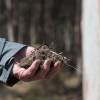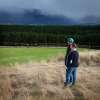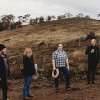
Formosa Estate virtual reality video - Shelterbelts increase pasture growth
Posted 23 June 2022
Plantation Planning Managing trees On-farm benefits PFT Tree Alliance
Forest Learning has released a series of agroforestry virtual reality videos including a case study of Formosa Estate that was part of the Agroforestry project ran by PFT in collaboration with CSIRO and UTAS.
The video shows the research scientists have conducted and the results shelterbelts have had on pasture growth through wind reduction.
In 2016, PFT launched the Agroforestry project in collaboration with CSIRO and UTas to demonstrate the benefits of trees in the agricultural landscape.
Equipment was installed at Formosa Estate situated in the north of the state at Cressy, to measure soil and atmospheric variables from forests to open fields measuring crop growth and animal movement in relation to shelterbelts established in 2001.
The paddock was grazed to a uniform starting point and stock excluded with the pasture being allowed to grow for around 7 weeks until early October 2017. Pasture biomass was measured and a total of 7 transects were established across the paddock with an automatic weather station to continuously monitor wind direction and speed. The shelterbelt was close to perpendicular to the bulk of the wind and reduced wind speed on average by around 50% over the sheltered half of the paddock.
In the spring of 2017, Formosa Estates pasture production was on average 30% higher in the sheltered half of the paddock compared to the unsheltered half.
A Pinus radiata shelterbelt on approximately 1ha (4%) of the paddock but induced a 15% increase in pasture growth over the remaining 24ha and effectively increased the pasture production to the equivalence of a 29ha paddock.
The study concluded that the impact of shelter on the gross margin was likely to be around $63/ha, or $1,500 in total across the paddock.
In addition to increased pasture production, shelter can also increase stock survival, provide carbon offsets and financial benefits at the time of harvest.
CLICK HERE to view Forest Learning Video (Click on the video and move your mouse to experience the full 360 degree view)
Share this Article
Latest Articles
-

20 October 2025
Tasmanian High Soil Carbon Landscapes project
-

17 September 2025
Celebrating excellence at the Tasmanian Timber Awards
-

17 September 2025
Forest Practices Authority Research Update Day
Archives
- ActivAcre hits milestone, calls for more farmers to get on board
- Napier's leading the way in sustainable forestry and carbon-neutral farming
- Sound science needed to assess carbon impacts of timber harvesting
- Newly appointed TFFPN Board of Directors
- Graduate Certificate of Forestry Scholarship
- Forestry Australia Mentoring Program 2025
- Forest Industry Roundtable planning for the long term
- Eagle Management Constraint Period extended
- Successful private native forest management celebrated
- $15 million investment in new ship loader to boost Bell Bay's forestry exports
- Standing with Tasmania's forestry industry: buy local
- TFPA: Tasmanian Freight Equalisation Scheme needs a ground-up review
- AFCA Gala Dinner celebrates industry excellence
- Fire permits now required Statewide
- Forest leaders hone skills in sustainable native regrowth management
- Tasmanian forests and the carbon market: Barriers and opportunities
- What the 2024-25 Tasmanian Budget means for forestry
- Spring is the time for fuel reduction burning
- Primed for Growth: A situation analysis of the Tasmanian Forest and Wood Products Sector
- Audit requirements cut for low-risk plantation projects
- Guidance and support for landowners after damaging winds
- Forestry Australia welcomes further definition of active forest management
- Farm & Forest Mapper Tool highlighted at Rural Youth Tasmania's Young Farmer of the Year competition
- Senate Select Committee inquiry into the Tasmanian Freight Equalisation Scheme
- Timberlink announces new wood composite products brand
- Newly developed protocol a vital tool for safeguarding forestry industry
- Red Hot Tips: Fire management for Tassie farmers
- Bioenergy: Fuelling industries with trees
- Harvesting trees: What you need to know
- Shelterbelts: How are they contributing to farm systems?
- Infill plantings and remnant vegetation: Why biodiversity depends on a thriving understory
- Plantation planning: The key to a successful plantation
- Exciting interactive forestry knowledge hub launched
- $450,000 farm forestry grant recipients revealed


